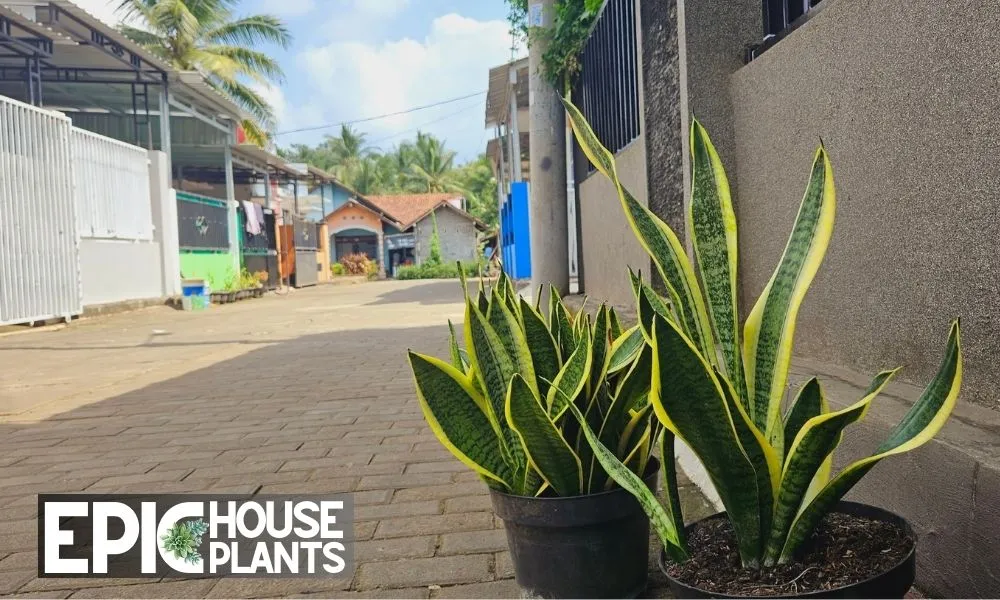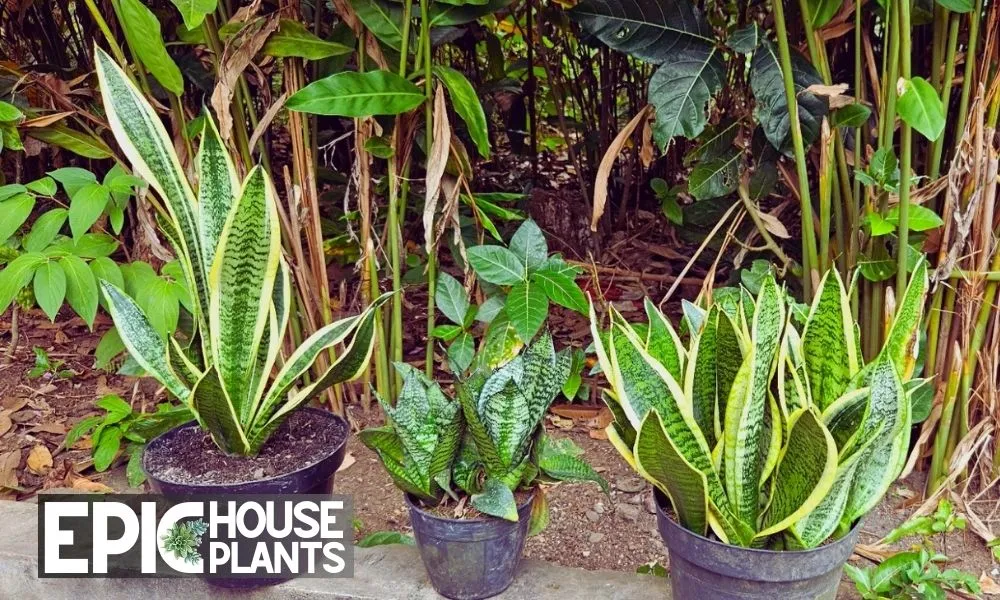Snake plants, known by the scientific name Dracaena trifasciata (previously Sansevieria trifasciata), are renowned for their hardiness and adaptability, making them popular houseplants across the globe.
But, have you ever wondered if these versatile gems can flourish outdoors? This article will enlighten you about the possibilities of nurturing snake plants in your garden or patio.

Can Snake Plants Live Outside?
The answer is a resounding ‘yes’. Snake plants can indeed live outdoors, but they’re still tropical plants at heart, and they prefer certain environmental conditions.
Meeting Snake Plant’s Preferences
Its ability to adapt to a variety of growing conditions and its air-purifying capabilities have cemented its position as a cherished houseplant.
However, for your beloved green companion to flourish outdoors, you need to recreate its native environment. Which means providing the perfect balance of temperature, light, humidity, and water.
The Ideal Temperature Range
Snake plants enjoy a tropical climate, preferring a temperature range of 55-90 degrees Fahrenheit. If the mercury falls below 50 degrees F, your plant will struggle, showing signs of distress, and can eventually meet its untimely demise.
For those living in USDA hardiness zones 9 to 11, where temperatures remain warm all year round, you’re in luck! These regions are perfect for growing snake plants outdoors.
The Sunlight Requirement
When it comes to sunlight, snake plants display a certain level of flexibility. They thrive under bright but indirect sunlight, with their growth slowing down in full shade or low light.
Beware of exposing your snake plant to direct sunlight, though, as this can lead to sun scorch, causing its leaves to turn a distressing shade of yellow.
The Water Requirement
Unlike many other plants, snake plants have a minimal water requirement. Their motto is less is more! Overwatering can lead to root rot, a common issue many plant owners dread.
On the other hand, underwatering can stunt the plant’s growth. Striking a balance is key for a happy, healthy snake plant.
Also Read: From Leaf to Life: Easy Guide to Propagate Snake Plant in Water
The Ideal Soil
Last but not least, soil plays a crucial role in the successful growth of outdoor snake plants. They prefer free-draining, nutrient-rich soil that doesn’t retain much water.
To achieve this, a succulent or cactus potting mix works well, or you can create your own mix using regular potting soil and coarse sand or perlite.
Author Note:
Your snake plant can enjoy life outside, but only if it receives the care it needs. Keep these factors in mind and your snake plant will not only survive but truly thrive in its outdoor home!
Moving Snake Plants from Indoors to Outdoors

If you’ve ever wondered whether your snake plant, thriving in your living room, could make the great leap to the outdoors, you’re in luck! They certainly can, and the transition is much simpler than you’d think.
But before you start, remember that snake plants, like us, need some time to adapt to new environments. Here’s a step-by-step guide to moving your snake plant outdoors without causing them undue stress.
1. The Gradual Approach: Avoiding Shock to Your Snake Plant
Sudden changes are not welcomed by snake plants. They’re like seasoned vacationers who prefer gradual transitions rather than abrupt leaps from one climate to another.
The key to successfully moving your snake plant outdoors is to gradually expose it to its new environment.
2. Acclimation: A Bit of Shade Goes a Long Way
The first step is to choose the right location. Snake plants aren’t sunbathing fanatics. Place your plant in a shady spot outside, away from direct sun exposure.
This will help them acclimate to the outdoor environment without the risk of sunburn.
3. Stepping Up the Game: Increasing Outdoor Exposure
Let your snake plant enjoy the outdoors for 3-4 hours each day. It’s best to bring them inside before dusk to avoid any drastic temperature changes.
Over the next week, increase the amount of time they spend outside by a few hours every other day. This gradual increase helps your plant adjust to its new surroundings without stress.
4. Full-Time Outdoor Living: Making the Final Move
After following this regime for a week, it’s time to introduce your plant to morning or evening sun for an hour or two, while the rest of the day can be spent under the shade.
Keep up this routine for another week. If all goes well, your snake plant is ready to be outside full-time!
5. Regular Checkups: Monitoring for Sun Damage
Inspect your plant daily, particularly for signs of sun damage. If everything seems right after a week, then you can let your plant stay outside permanently. But remember to check regularly for any changes or signs of distress.
6. Watering and Fertilization: Encouraging Healthy Growth
Water your snake plant only when the soil is completely dry. Snake plants have a low water requirement, so overwatering can cause root rot.
With increased light exposure, your plant will likely grow more, so remember to fertilize more often. This will ensure your snake plant gets the nutrients it needs to thrive in its new environment.
7. Weather Watch: The Final Checkpoint
After any harsh weather, inspect your plant for any damage. Snake plants are hardy but could still suffer under severe weather conditions.
Author Note:
Moving your snake plant from indoors to outdoors isn’t a difficult task. All you need to do is gradually acclimate your plant to its new environment, provide it with the right care, and monitor its health regularly.
Your snake plant will love its new home, and you’ll have a new outdoor companion.
FAQs: Navigating Snake Plants’ Outdoor Adventures
Whether you’re a seasoned snake plant owner or a newbie, it’s common to have questions about this popular houseplant’s transition to the outdoors.
Here are answers to three frequently asked questions to guide you on your journey to outdoor snake plant success.
1. Can Snake Plant Survive Outside in Winter?
Snake plants, originating from the warm tropics, aren’t built to withstand freezing temperatures. During winter, when temperatures dip into the chilly zone, snake plants can suffer. Hence, it is advisable to keep your snake plants indoors during this season.
But don’t lose heart! With proper care and protection, such as using protective covers or moving them to a sheltered location, your snake plant might just brave the winter outdoors.
But remember, this involves considerable effort and close monitoring, so if you’re unsure, it’s best to keep your plant warm indoors until the warmer weather returns.
2. Can Snake Plants Thrive Outside in Hot Summers?
While snake plants are more accustomed to warmer climates, they still have their limits. In regions experiencing intense, scorching summers, snake plants may suffer from sunburn if exposed to direct sunlight.
The best approach is to provide them with bright but indirect light, and to avoid placing them under the harsh midday sun.
Remember to keep an eye on the water levels during hot summers. Although snake plants have minimal water requirements, the heat might make the soil dry out faster. However, always ensure the soil is dry before watering to avoid root rot.
3. How Can I Protect My Outdoor Snake Plant from Pests?
Snake plants are generally pest-resistant, but an increase in humidity or other changes in outdoor conditions might make them more susceptible to pests. Regular inspections are crucial.
If you notice any infestation, consider spraying some neem oil on the plant, a natural solution to fend off pests. A monthly application is typically enough to keep your snake plant healthy and pest-free.
Also Read: Repotting Snake Plant Like a Pro: A Comprehensive Guide
Final Words
With these guides, FAQs, and tips at your fingertips, you’re now armed with all the knowledge you need to help your snake plant transition smoothly from indoors to outdoors. Remember, patience is key – your plant won’t acclimate overnight.
But with time, care, and a bit of plant-parent love, your snake plant will soon be embracing its new outdoor home. So, step out, soak up the sunshine, and enjoy this exciting gardening adventure with your snake plant! Happy gardening!
Author

Pudji Haryanto
Pudji Haryanto is a writer and urban farmer with a passion for cultivating plants. He has over 15 years of experience in agriculture and currently manages a 65,000 square foot rice-field and yard filled with various plants, including vegetables, spices, flowers, and garden plants.

